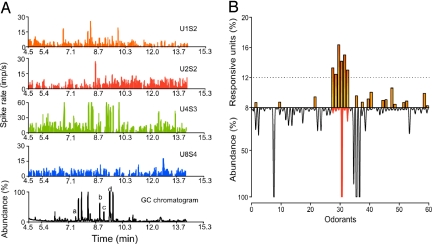Fig. 2.
Responses of AL neurons to GC-fractionated scent from A. palmeri flowers. (A) Rate histograms (bin size, 100 ms) of single-unit responses to the eluting compounds from the A. palmeri headspace extract (1-μL injection) (bottom trace). Each unit was recorded from one of the four shanks on the electrode array (11 units monitored in the ensemble). Peaks a–d in the chromatogram (bottom record) correspond to ethyl tiglate, propyl valerate, myrcene, and ethyl sorbate, respectively. Certain odorants [e.g., ethyl tiglate (a) and ethyl sorbate (d)] evoked significant responses in units on different shanks. (B) The percentage of responsive units in each ensemble (threshold RI ≥ ± 2.0) was determined for each odorant in the floral headspace and plotted for each preparation (n = 6). Odorant numbers correspond to retention times, except for those odorants that gave robust responses (odorants 28–33), which were rearranged for clarity. A threshold of 12% (dotted line) of the entire dataset was used to identify the odorants that evoked the greatest activity: Bbu, Myr, Etg, Esb, Bea, and Pvl (odorants 28–33, respectively).

